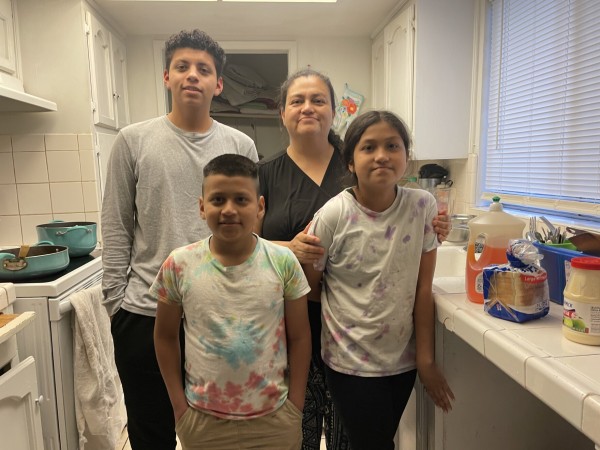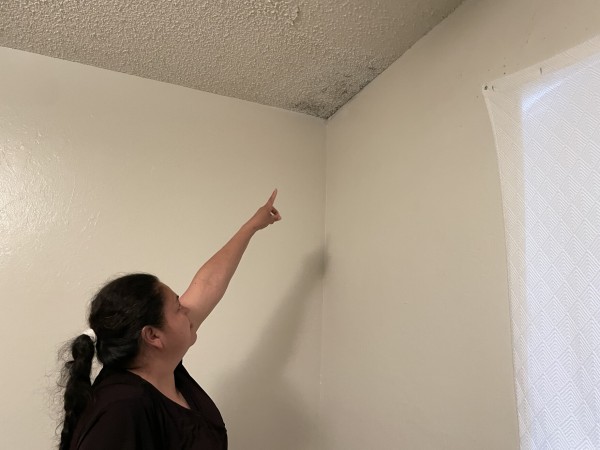KVPR | By Madi Bolanos

Maria Rubio and three of her children pose in their kitchen in Madera on May 2, 2022. Photo: Madi Bolaños.
It’s a warm Monday evening in the city of Madera. Maria Rubio’s youngest kids are playing a video game in the living room. The windows are closed and the blinds are drawn to keep the heat out and the house cool.
But Rubio worries about what they can’t keep out. She points to a corner in her bedroom where black clusters of mold are forming on the walls.
“That right there, it’s all just getting bigger,” she says in Spanish.
Rubio and her five kids have had asthma for years. Rubio and her oldest son were diagnosed first, almost 20 years ago. She says the doctors told her there were a number of things that could trigger asthma, including dust mites, mold, cockroaches, pesticides and air pollution.
The Rubio family is among roughly two million low-income Californians who have health insurance coverage through Medi-Cal and have been diagnosed with asthma. About 220,000 of them have poorly controlled asthma, according to state data.
At the beginning of this year, the California Department of Health Care Services rolled out a new program to help Medi-Cal recipients improve their health by eliminating asthma triggers in their homes. The program will offer a select number of enrollees remediation services like removing mold, installing air purifiers and even replacing carpeting, blinds and mattresses.
The asthma efforts are part of an initiative called CalAIM, a $8 billion effort to transform Medi-Cal and target the state’s sickest and most expensive patients.
But five months after the asthma program launched, families in the San Joaquin Valley are still struggling to get these services.

Maria Rubio points to the black clusters of mold growing in the corner of her bedroom. Photo: Madi Bolaños.
“The thing that bothers me the most is it’s more cumbersome for the patient,” says Kevin Hamiliton, director of the Central California Asthma Collaborative, the organization coordinating with five Medi-Cal health plans to deliver these services in the San Joaquin Valley.
For example, the Rubio family would first need a referral from a medical provider. From there, their Medi-Cal health plan would have to approve the referral. Once it’s been approved, the partnering community-based organization – in this case, the collaborative – would visit their home to determine what services are needed. Then the organization would return the assessment to the health plan for one final approval before it can move forward with the services.
So how many Valley residents have Medi-Cal plans referred to the Central California Asthma Collaborative for services since the program launched Jan. 1?
Just one, according to Hamilton.
That’s out of the thousands of eligible Medi-Cal patients in Madera, Fresno, Tulare, Kings and Kern counties, according to Jacey Cooper, the California Medicaid Director. She acknowledges the program’s slow start but says it’s expected.
“I think identifying individuals, training providers to make referrals for new services, education and outreach to providers and beneficiaries, all of those things take a little bit of time to get nuanced and implemented,” she says.
Back in Madera, Maria Rubio examines the wood under the sink in her kitchen. It’s expanding due to humidity, which is another asthma trigger.
“I asked the landlord to change it, but they just put in another wood panel and painted over it,” she says.
She says she’s tried to ask her landlord to fix these issues, but she’s usually met with no response or cheap fix-it solutions. And she says she’s scared to keep asking.
“I didn’t want to ask for anything more because we’ve been kicked out of our rental before, with nowhere to go,” she says.
She says a community health worker told her about the state’s new asthma services and she thinks they could be really helpful.
“I heard that there’s going to be assistance to help us live a little better in our home, so we don’t continue to suffer from these illnesses,” she says.
Her family could qualify for the program but would generally need to get a referral. Rubio is hesitant to go to the doctor because of bad experiences in the past. It’s one more obstacle the state faces in helping families that need these services the most.
KHN’s Angela Hart contributed reporting to this story.
This story is part of the Central Valley News Collaborative, which is supported by the Central Valley Community Foundation with technology and training support by Microsoft Corp.













